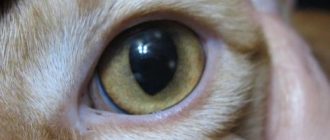Acne in cats is more common than many people think, and although it is more obvious in cats with a light color, it can occur in absolutely any cats, not limited to any breed or color. Acne appears as a cluster comedones (blackheads) and is found, usually on the chin. Most often it occurs in young cats aged 2 to 4 years, and looks at first glance like dirt (black dots on the chin). Acne can occur for a variety of reasons, including due to stress, poor care, food allergies or certain medications, but the most common cause is increased sebaceous activity glands and hormones, i.e. same as teenagers.

The sebaceous glands are associated with the hair follicles and produce sebum secretion which provides waterproof Wool and protects the skin. If a cat rubs its head against walls or furniture, then this is not unusual, since thereby leaves its smell. In case of acne, cat hair follicles clogged with sebum and cause acne familiar to all.
If you do not treat acne, then they can turn into swollen red pustules that will cause further irritation and may bleed if the cat scratches them. In the extreme in cases, the veterinarian may recommend drainage (cleaning) of the abscess, which you should not conduct yourself. In some cases, secondary fungal infections occur, which, certainly require professional treatment by a veterinarian.
Sometimes, acne in cats manifests itself in another form known as “greasy tail” when in the upper part of the tail closest to the body a bold and dark secret appears. This condition is usually occurs in full-fledged non-castrated cats.
Cat Acne Treatment
In most cases, acne in cats is treated by brushing. light soapy solution two or three times a day. Or you can try using one of the acne remedies in adolescents, however, for this you should consult your veterinarian at account of the most suitable and safe means that are not will cause any unpleasant side effects in your cat. By however, cats can be quite adept at removing ointments and creams so you can have success variables with these means. You can also try to clean the chin area. a soft enough toothbrush dipped in a mild soap solution, trying to prevent the occurrence of bleeding that may cause infection. Under no circumstances squeeze blackheads, as this will inevitably lead to further infection.
If the problem is not resolved quickly enough, or at least at least, there will be no signs of some improvement, then you should consult your veterinarian for advice. In the most serious cases your veterinarian may prescribe an extended antibiotic course for your cat based on testing bacterial cultures. In the very extreme In cases, the veterinarian may prescribe treatment with steroids, to reduce inflammation. Most cases of acne are good can be cured with drugs, but on your part some effort and a period of time in few weeks.
Many veterinarians and breeders believe that acne on the chin cats can become aggravated due to plastic bowls, as they porous and can accumulate bacteria, which are then transmitted cat, so you should consider replacing such a bowl with ceramic or metal. Hygiene is always paramount value when it comes to acne, therefore, it is important that you regularly and thoroughly wash all bowls to avoid any infection, and also do not forget to wash your hands thoroughly after each handling a sick cat.
If you or your veterinarian considers the main cause of acne insufficient cat care, then you must take all measures to keep affected areas clean. The same way, if your cat is a “dirty eater” then you need to check her chin after each meal, or train her more neat way of feeding.
Any problems with acne in cats need to be addressed for their sake. well-being, and if you, for example, try to take your a pet with overt acne at a cat show or competition then he probably will not be allowed during the inspection, as the judge is almost surely tag the cat.
After the cat develops acne, it’s probably a disease will become a regular problem. But in those cases when it is caused hyperactivity of the sebaceous glands or hormones, good news is that cats are likely to grow out of this soon “teenage” age.






